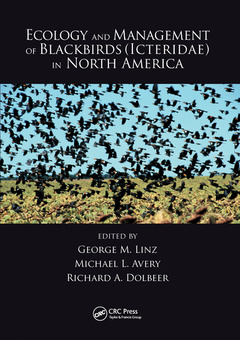Ecology and Management of Blackbirds (Icteridae) in North America
Coordonnateurs : Linz George M., Avery Michael L., Dolbeer Richard A.

Shortlisted for the 2018 TWS Wildlife Publication Awards in the edited book category
The various species of new world blackbirds, often intermingled in large foraging flocks and nighttime roosts, collectively number in the hundreds of millions and are a dominant component of the natural and agricultural avifauna in North America today. Because of their abundance, conspicuous flocking behavior, and feeding habits, these species have often been in conflict with human endeavors.
The pioneering publications on blackbirds were by F. E. L. Beal in 1900 and A. A. Allen in 1914. These seminal treatises laid the foundation for more than 1,000 descriptive and experimental studies on the life histories of blackbirds as well as their ecology and management in relation to agricultural damage and other conflicts such as caused by large winter roosting congregations. The wealth of information generated in over a century of research is found in disparate outlets that include government reports, conference proceedings, peer-reviewed journals, monographs, and books.
For the first time, Ecology and Management of Blackbirds (Icteridae) in North America summarizes and synthesizes this vast body of information on the biology and life histories of blackbirds and their conflicts with humans into a single volume for researchers, wildlife managers, agriculturists, disease biologists, ornithologists, policy makers, and the public. The book reviews the life histories of red-winged blackbirds, yellow-headed blackbirds, common grackles, and brown-headed cowbirds. It provides in-depth coverage of the functional roles of blackbirds in natural and agricultural ecosystems. In doing so, this authoritative reference promotes the development of improved science-based, integrated management strategies to address conflicts when resolutions are needed.
History of Research and Management, Policy and Regulations of Blackbirds. Red-winged Blackbirds. Yellow-headed Blackbirds. Common Grackles. Brown-headed Cowbirds. Effects of Habitat and Climate Change on Blackbird Populations. Population Dynamics and Management of Blackbird Populations. Repellents. Frightening Devices. Evading Strategies. Case Study: Using Harvest Theory and the Prescribed Take Level Framework to Assess Allowable Take of a Population of Red-winged Blackbirds in the northern Great Plains. The Economic Impacts of Bird Damage to Crops. The Future of Blackbird Management in United States.
DR. GEORGE LINZ is a recently retired Research Wildlife Biologist at the National Wildlife Research Center. He served as the North Dakota Field Station Leader and the Blackbird-Sunflower research project leader for 25 years. Dr. Linz has led multiple studies in basic and applied wildlife biology, including (1) prevalence of avian-borne diseases in dairies and feedlots, (2) use of aquatic herbicides for altering roost habitat favored by blackbirds in North Dakota, (3) migration patterns of blackbirds in relation to sunflower damage, and (4) use of alternative feeding sites (wildlife conservation sunflower plots) for reducing blackbird damage to crops.
DR. MICHAEL AVERY is the Project Leader of the National Wildlife Research Center's Florida Field Station in Gainesville. He is recognized nationally and internationally for his expertise in a number of wildlife management areas including avian collisions with manmade structures (towers, powerlines, etc.); avian damage to grain and fruit crops; repellents and chemical deterrents; avian contraception methods.
DR. RICHARD DOLBEER is a retired Research Wildlife Biologist at the National Wildlife Research Center and USDA APHIS Science Advisor. He served as project leader of the Wildlife Services, National Wildlife Research Center, Sandusky, OH, field station from 1971-2002. Dr. Dolbeer led several research programs focused on resolving wildlife-human conflicts, from blackbird depredations in grain crops to aircraft engines ingesting birds.
Date de parution : 06-2020
17.8x25.4 cm
Date de parution : 06-2017
17.8x25.4 cm
Thèmes d’Ecology and Management of Blackbirds (Icteridae) in... :
Mots-clés :
Mycobacterium Avium Paratuberculosis; Johne’s Disease; Economic impacts of birds; Normalized Difference Water Index; Agricultural impacts of birds; Sweet Corn; Human-wildlife conflict reduction; Red Winged Blackbirds; Conservation management; Yellow Headed Blackbird; Wildlife damage; Blackbird Damage; Michael L; Avery; Common Grackle; Richard A; Dolbeer; USDA Wildlife Service; Page E; Klug; Blackbird Populations; Daniel J; Twedt; Frightening Devices; Brian D; Peer; North American Breeding Bird Survey; Eric K; Bollinger; Prairie Pothole Region; Virginia E; Abernathy; Wildlife Damage Management; Greg M; Forcey; Cowbird Parasitism; Wayne E; Thogmartin; Bird Damage; Scott J; Werner; Juvenile Survival Rate; Michael C; Runge; Methyl Anthranilate; John R; Sauer; Intrinsic Growth Rate; Stephanie A; Shwiff; Karina L; Ernest; Female Cowbirds; Samantha L; Degroot; WNV Antibody; Aaron M; Anderson; Perennial Sunflower; Steven S; Shwiff; Unmanned Aircraft Systems



